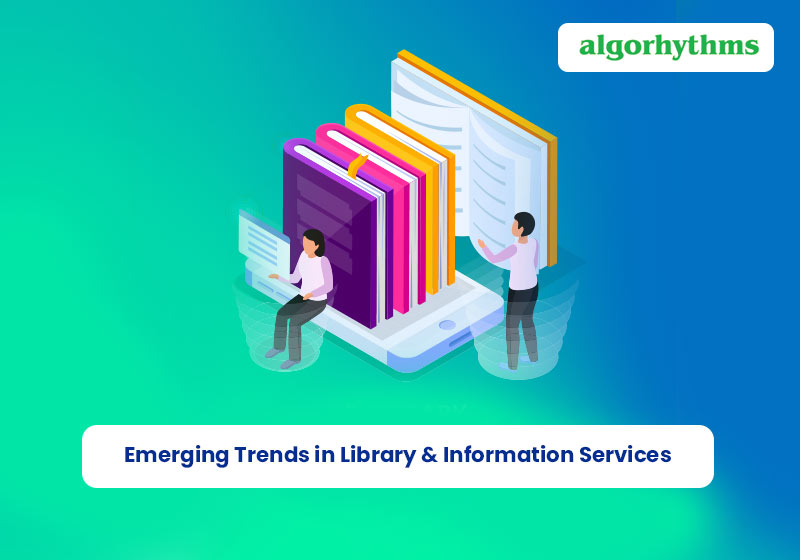Libraries are one of the foremost critical social institutions. No society is complete without a library storing information from the world over. Information and Communication Technology (ICT) have extensively impacted libraries and their services.
Earlier, libraries offered manual information resources and services to their users, but now, libraries are opening up to digitalization, primarily in the form of online libraries, eLibraries, or digital libraries.

Scroll down to know more about the top 9 current trends in the library management system and information services.
The Top 9 Current Trends in Library And Information Services
1. Electronic Resource Management
Electronic resources refer to e-journals, e-books, online databases, and other materials in digital formats, which are accessible electronically. e-Resource Management Software can be employed by libraries to trace the collection, access, authorization, maintenance, usage, evaluation, reservation, and selection of a library’s electronic information resources.
2. RFID Implementation
Radio-Frequency Identification (RFID) uses electromagnetic fields to select and track tags attached to library items automatically. The RFID-based library management system is the newest technology used to track inventory and strengthen library theft detection systems. This technology enhances the security of libraries and increases their efficiency by streamlining the processes and reducing human dependence. For the users, RFID accelerates the borrowing and return procedures. Hence, RFID saves time and reduces library costs.
3. Cloud Computing
Libraries across the world are adopting cloud computing to make library services more streamlined and cost-efficient. This library management system plays a significant role in building digital libraries or repositories. Cloud computing also ensures optimal use of library resources, infrastructure, human resources, etc. Moreover, the technology is also used for library automation and quick data search. Additionally, in a digital library, cloud computing ensures that third-party services can manage servers, carry out upgrades, and create data backups.
4. Internet of Things
The best-integrated library software and LMS software have started using the Internet of Things (IoT) to transfer data without human intervention. Libraries use IoT to control inventory, prevent theft, and identify users. It also helps in improving the quality and speed of circulation desk activities. Moreover, IoT expedites reservation of books, fire detection in the library and its prevention, and streamline eLibrary services.
5. Big Data and Data Visualization
Big Data and Data Visualization is the method of displaying a large volume of data through charts, graphs, maps, and other visual forms. This makes the info more natural for the human mind to grasp and makes it easier to spot trends, patterns, and outliers within large data sets. This technology is helping digital libraries become more globalized while accessing a vast amount of data. It makes the libraries more easily accessible to readers who can find a plethora of information at their fingertips.
6. Artificial Intelligence
Artificial intelligence (AI) uses the power of a robot or a computer that tries to do tasks that humans usually do. The most common application of AI in a library is the chatbots that receive directional questions from users and resolve them. They can alert the user about their book submission due date, direct a user to the relevant library segment, and automatically schedule appointments.
7. Mobile-Based Library Services
The three main objectives of a library are to promote literacy, disseminate useful daily information to the people and encourage lifelong learning through its reading materials and resources. Mobile libraries bring resources outside of the library’s fixed location to users who otherwise might not get an opportunity to profit from them.
With the help of mobile services like SMS and WhatsApp, libraries can produce new services and provide faster access to their collection. It also includes a learning management system (LMS), a software application that provides the framework that handles all aspects of the learning process and tracks your training content.
An example of the best LMS software is Moodle. The OPAC mobile application is a classic example of mobile-based library services. The platform is operated by SLIM Softwares and aims at converting conventional libraries to digital libraries.
8. Intelligent Library Search & Federated Search
Federated search and Intelligent Library Search are techniques to retrieve information from many different content locations with only one query and one search interface with federated search. The technology complements main libraries in retrieving information quickly and makes indexing seamless. Libraries also use this technology for descriptive cataloging, subject indexing, database searching, and collection development.
9. Academic Integrity and Plagiarism
Any discussion about current trends in library systems will be incomplete without mentioning academic integrity and plagiarism. Plagiarism is using another’s ideas, words, theories, illustrations or graphics, opinions, or facts without giving credit. For students, copying others’ work damages the intellectual integrity of their academic experience. Therefore, avoiding plagiarism has become the need of the hour.

Technology has undoubtedly made our lives much simpler. A library is no more the same it was a decade ago. Modern-day school and corporate library software ensure that you get the latest technologies in library systems right at your fingertips.

